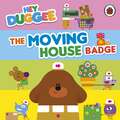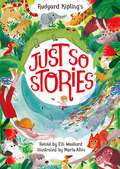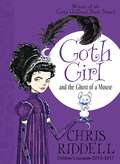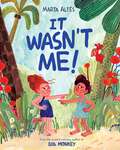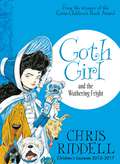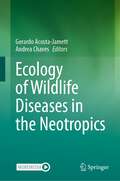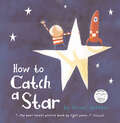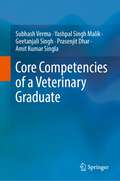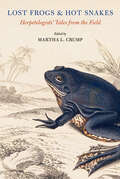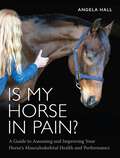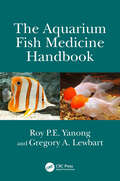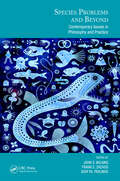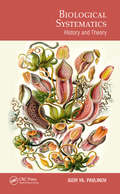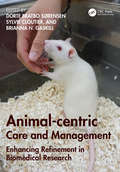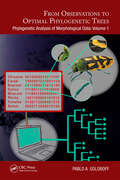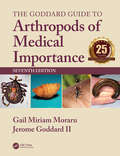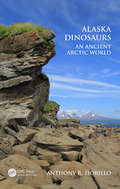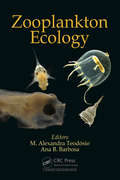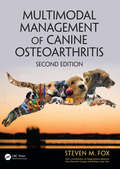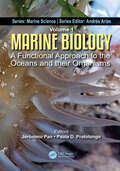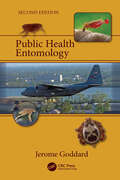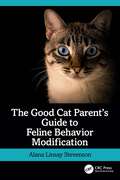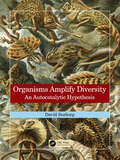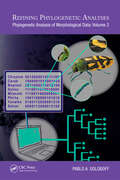- Table View
- List View
Hey Duggee: The Moving House Badge (Hey Duggee)
by Hey DuggeeMoving house can be hard. Can Duggee and the Squirrels help Snail to move house easily?Join everyone's favourite dog in this funny tale for budding young Squirrels!Duggee teaches the Squirrels to LIFT, PUSH, PULL and ROLL to move Snail's things efficiently.Want more Duggee? Try:Hey Duggee: The Potty BadgeHey Duggee: The Handwashing BadgeHey Duggee: The Football Badge
Rudyard Kipling's Just So Stories, retold by Elli Woollard: Book and CD Pack
by Elli WoollardDelightfully retold in humorous verse, with stunning illustrations throughout, this is a beautiful reworked edition of Rudyard Kipling's children's classic, Just So Stories. A gorgeous gift for imaginative young readers.In this highly illustrated collection meet the cat who walked by himself, discover how the lazy camel got his hump, how the elephant got his long trunk, find out why the rhino has such wrinkly skin and how the whale got his teeny tiny throat. These well known, richly imagined stories tell of how the world came to be as it is. This is a smart, funny and younger approach to Kipling's work, and Just So Stories as you've never seen them before. Rudyard Kipling's Just So Stories are one of the enduring classics of children's literature and these witty, inventive stories have delighted generations of children. Combining the brilliant rhyming talent of Elli Woollard and beautiful illustrations from the award-winning Marta Altés, Rudyard Kipling's Just So Stories is an enchanting retelling of a much-loved classic for a new generation. A book to truly treasure and one you will want to share.
Goth Girl and the Ghost of a Mouse (Goth Girl #1)
by Chris RiddellFull of adventure and humour, Goth Girl and the Ghost of a Mouse is the beautifully illustrated winner of the Costa Award – presented here in a gorgeous hardcover. From Chris Riddell, author of the Ottoline series, it is perfect for fans of Howl's Moving Castle and Netflix's Wednesday. Ada Goth is the only child of Lord Goth. The two live together in the enormous Ghastly-Gorm Hall. Lord Goth believes that children should be heard and not seen, so Ada has to wear large clumpy boots so that he can always hear her coming. This makes it hard for her to make friends and, if she's honest, she's rather lonely.Then one day William and Emily Cabbage come to stay at the house, and together with a ghostly mouse called Ishmael they and Ada begin to unravel a dastardly plot that Maltravers, the mysterious indoor gamekeeper, is hatching. Ada and her friends must work together to foil Maltravers before it's too late!Though they can be enjoyed in any order, continue this deliciously dark series with Goth Girl and the Fete Worse Than Death and Goth Girl and the Wuthering Fright.
It Wasn't Me!
by Marta AltésHilarious, heartwarming and full of charm, It Wasn't Me! is a fun and reassuring tale of friendship, falling out and forgiveness from CILIP Kate Greenaway Medal nominee and BookTrust Time to Read favourite, Marta Altés.Meet Ellis and Charlie: two friends, living happily on their very own island. Everything they do, they do together, and everything they have, they share. Until, that is, things start to go missing . . .NOBODY is owning up and NOBODY is happy about it. But if it isn't Ellis and it isn't Charlie, then WHO IS IT?Children will love spotting the real culprit in this funny and engaging tale, which shows that even the firmest of friends sometimes fall out - but not, usually, for very long!
Goth Girl and the Wuthering Fright (Goth Girl #3)
by Chris RiddellThe third beautifully illustrated book in the series, Goth Girl and the Fete Worse Than Death is a funny, spooky adventure from the Costa Award-winning author of the Ottoline books, Chris Riddell.People are flocking to Ghastly-Gorm Hall from far and wide to compete in Lord Goth's literary dog show. The esteemed judges are in place and the contestants are all ready to win. Sir Walter Splott is preparing his Lanarkshire Lurcher, Plain Austen is preening her Hampshire Blue Bloodhound and Homily Dickinson and her Yankee Doodle Poodle are raring to go. But there's something strange going on at Ghastly-Gorm – mysterious footprints, howls in the night and some suspiciously chewed shoes. With their new friends the Vicarage sisters – Charlotte, Emily and Anne – can Ada and the Attic Club work out what's going on before the next full moon?Though they can be enjoyed in any order, continue this deliciously dark series with Goth Girl and the Sinister Symphony.
Ecology of Wildlife Diseases in the Neotropics
by Gerardo Acosta-Jamett Andrea ChavesThis contributed volume focuses on the Neotropical region, and explores the environmental, ecological and socio-economic components that facilitate the emergence of zoonotic diseases. This book highlights the primary ecological, environmental, social, and economic variables associated with the risk of maintenance, transmission, and dissemination of emerging, re-emerging, and neglected infectious diseases, in which Neotropical vertebrates are involved. It compiles up-to-date knowledge and research for the neotropical region, as well as discusses the current needs of knowledge improvement. The chapters include various examples of the cycles of infectious diseases, all with world-wide relevance where neotropical wild vertebrates are affected or involved.
How to Catch a Star (Read aloud by Paul McGann)
by null Oliver JeffersThis is a read-along edition with audio synced to the text, performed by Paul McGann. An inspirational story of a boy who loved the stars so much, he decided to catch one of his very own. The beautifully illustrated, original debut picture book from shining talent Oliver Jeffers. There once was a boy who loved stars so much that he wished he had one of his very own. Every night he watched the stars in the sky from his bedroom window and dreamed of how he could be their friend and how they could play hide-and-go-seek together. So, one day, he decided to set about catching a star of his very own…
Core Competencies of a Veterinary Graduate
by Subhash Verma Yashpal Singh Malik Geetanjali Singh Prasenjit Dhar Amit Kumar SinglaThis book is an essential guide for veterinarians, veterinary faculty and policymakers for understanding the core competencies of a fresh veterinarian. The book briefly covers competencies in preclinical, paraclinical, and clinical subjects including anatomy, physiology, biochemistry, veterinary jurisprudence, animal management & welfare including nutrition and breeding, infectious and non-infectious diseases, disease epidemiology, diagnosis, and treatment, prevention, control and zoonoses, surgical and other clinical interventions. The book further includes other competencies, including biologicals, anti-mortem, and post-mortem inspection, certifications, applied one health aspects, review and analysis of scientific evidence, international trade and regulations, and organization of veterinary services. It also highlights the importance of effective communication, interpersonal skills, record keeping and management of a small veterinary hospital, health informatics, etc. The book breakdowns the must-have competencies of a global veterinarian into different topics and subtopics for easy comprehension and further learning. It enables the professional standard-setting & regulatory bodies and academicians in improved curricula designing and implementation and more importantly tries to bring uniformity in day one veterinary graduates’ competencies globally, enhancing the movement and employability of veterinarians across the world.
Lost Frogs and Hot Snakes: Herpetologists' Tales from the Field
by Martha L. CrumpLost Frogs and Hot Snakes reveals the thrills and travails that herpetologists experience when working with amphibians and reptiles in the wild. With essays from fifty field biologists, this volume, edited by Martha L. Crump, presents a multifaceted yet intimate look at life in pursuit of knowledge about the natural world. From the beaches of Peru to the mountains of China, the stories in this collection place readers in the boots of field biologists as they watch, count, experiment, and survey. Some recall mishaps and misadventures—contending with leeches, dangling off a precipice while in a truck. Others tell of once-in-a-lifetime encounters—discovering a new frog species, spotting a rare snake. Together, these stories offer an understanding of what field biology is, what field biologists do, and how they go about doing it. Written with candor, warmth, and a dash of humor, the stories in Lost Frogs and Hot Snakes will encourage readers to appreciate the value of engaging with nature and of the amphibians and reptiles so critical to the vitality of our planet.
Is My Horse in Pain?: A Guide to Assessing and Improving Your Horses Musculoskeletal Health and Performance
by Angela HallIs My Horse in Pain is an invaluable resource for all equestrians. The secrets of equine body language are unveiled, enabling readers to interpret the subtle messages hidden within the horse's gestures, postures and gaits. This book helps readers to understand and recognise these signs of pain and discomfort, taking appropriate measures to address and alleviate them. With this book acting as their guide, equestrians will be equipped with the tools to become knowledgeable and empathetic advocates, ensuring the well-being and happiness of their horses through enhanced performance and pain reduction.
The Aquarium Fish Medicine Handbook
by Roy P.E. Yanong Gregory A. LewbartPracticing veterinarians, veterinary technicians, professional aquarists, fish researchers, and tropical fish hobbyists will find this thorough yet concise handbook a complete how-to guide for keeping fish under human care healthy and thriving. Whether you're new to fish medicine and husbandry or an expert in the field, there is valuable information within these pages for you. The book is arranged in a logical order so that readers can quickly and efficiently find the information they seek. The book is filled with valuable and applicable information on dozens of topics including how to manage aquatic life support systems for fish, history taking, natural history, anatomy, physiology, diagnostic techniques, anesthesia, analgesia, and surgery. Virtually all of the most important ornamental fish pathogens, including viruses, bacteria, fungi, and parasites, are described and richly illustrated. There are also sections on fish welfare and conservation.While there are many books on the market that explore the topics of ornamental fish health and care, none provide the amount of helpful information and resources in such a small, affordable package.
The Aquarium Fish Medicine Handbook
by Roy P.E. Yanong Gregory A. LewbartPracticing veterinarians, veterinary technicians, professional aquarists, fish researchers, and tropical fish hobbyists will find this thorough yet concise handbook a complete how-to guide for keeping fish under human care healthy and thriving. Whether you're new to fish medicine and husbandry or an expert in the field, there is valuable information within these pages for you. The book is arranged in a logical order so that readers can quickly and efficiently find the information they seek. The book is filled with valuable and applicable information on dozens of topics including how to manage aquatic life support systems for fish, history taking, natural history, anatomy, physiology, diagnostic techniques, anesthesia, analgesia, and surgery. Virtually all of the most important ornamental fish pathogens, including viruses, bacteria, fungi, and parasites, are described and richly illustrated. There are also sections on fish welfare and conservation.While there are many books on the market that explore the topics of ornamental fish health and care, none provide the amount of helpful information and resources in such a small, affordable package.
Species Problems and Beyond: Contemporary Issues in Philosophy and Practice (Species and Systematics)
by John S. Wilkins, Frank E. Zachos, and Igor Ya. PavlinovSpecies Problems and Beyond offers a collection of up-to-date essays discussing from an interdisciplinary perspective the many ramifications of the ‘Species Problem.’ The authors represent experts in the philosophy of biology, in species-level evolutionary investigations, and in biodiversity studies and conservation. Some of the topics addressed concern the context sensitivity of the term ‘species’; species as individuals, processes, natural kinds, or as ‘operative concepts’; species delimitation in the age of Big (genomic) Data; and taxonomic inflation and its consequences for conservation strategies. The carefully edited volume will be an invaluable resource for philosophers of biology and evolutionary biologists alike. – Olivier Rieppel, Rowe Family Curator of Evolutionary Biology, Negaunee Integrative Research Center, Field Museum, USASpecies, or ‘the Species Problem’, is a topic in science, in the philosophy of science, and in general philosophy. In fact, it encompasses many aspects of the same problem, and these are dealt with in this volume. Species are often thought of as fundamental units of biological matter to be used in ecology, conservation, classification, and biodiversity. The chapters in this book present opposing views on the current philosophical and conceptual issues of the Species Problem in biology.Divided into four sections, Concepts and Theories, Practice and Methods, Ranks and Trees and Names, and Metaphysics and Epistemologies, the book is authored by biologists, philosophers, and historians, many leaders in their fields. Topics include ontology of species, definitions of both species category and units, species rank, speciation issues, nomenclature, ecology, and species conservation.Species Problems and Beyond aims to clarify the contemporary issues of the Species Problem. It is ideal for use in upper-level seminars and courses in Evolutionary Biology, Philosophy of Science, Philosophy of Biology, Systematics and Taxonomy, and Phylogenetics/Cladistics, and for any scholar in these fields.
Biological Systematics: History and Theory (Species and Systematics)
by Igor PavlinovThis volume reviews the historical roots and theoretical foundations of biological systematics in an approachable text. The author outlines the structure and main tasks of systematics. Conceptual history is characterized as a succession of scientific revolutions. The philosophical foundations of systematic research are briefly reviewed as well as the structure and content of taxonomic theories. Most important research programs in systematics are outlined. The book includes analysis of the principal problematic issues as "scientific puzzles" in systematics. This volume is intended for professional taxonomists, biologists of various specialties, students, as well as all those interested in the history and theory of biology and natural sciences.Key Features Considers the conceptual history of systematics as the framework of evolutionary epistemology Builds a hierarchically organized quasi-axiomatic system of taxonomic theory Contends that more reductionist taxonomic concepts are less objective Supports taxonomic pluralism by non-classic philosophy of science as a normal condition of systematics Documents that "taxonomic puzzles" result from conflict between monistic and pluralistic attitudes Related Titlesde Queiroz, K. et al., eds. Phylonyms: A Companion to the PhyloCode (ISBN 978-1-1383-3293-5)Sigwart, J. D. What Species Mean: A User's Guide to the Units of Biodiversity (ISBN 978-1-4987-9937-9)Rieppel, O. Phylogenetic Systematics: Haeckel to Hennig (ISBN 978-1-4987-5488-0)Wilkins, J. S. Species: The Evolution of the Idea, 2nd ed. (ISBN 978-1-1380-5574-2)
Animal-centric Care and Management: Enhancing Refinement in Biomedical Research
by Dorte Bratbo Sørensen, Sylvie Cloutier, and Brianna N. GaskillThe concept of the 3Rs (Refinement, Reduction and Replacement) has been used as a framework for improving the welfare of laboratory animals for the last half century. By establishing an animal-centric view on housing and management, Animal-centric Care and Management: Enhancing Refinement in Biomedical Research takes Russell and Burch’s definition of Refinement as "elimination of inhumanities" and goes further. Rather than fitting animals into experimental conditions, it encourages readers to adjust conditions to better meet the behavioral, emotional, physical, and physiological needs and preferences of the animals. The team of expert authors, from the fields of laboratory animal science, ethology, biology as well as animal training, provide ideas for creating housing conditions and handling procedures that induce, to the best of current abilities and knowledge, a long-term positive state of mind in the animals under our care. This book is written for animal caretakers, animal health technicians, researchers, animal facility managers, laboratory animal veterinarians, and anyone who engages in work with living experimental animals or is interested in the continuous improvement of laboratory animal welfare. This interdisciplinary guide will act as a catalyst, resulting in multiple viewpoints and fields collaborating to optimize laboratory animal welfare.
From Observations to Optimal Phylogenetic Trees: Phylogenetic Analysis of Morphological Data: Volume 1 (Species and Systematics)
by Pablo A. GoloboffTaxonomists specializing in different groups once based phylogenetic analysis only on morphological data; molecular data was used more rarely. Although molecular systematics is routine today, the use of morphological data continues to be important, especially for phylogenetic placement of many taxa known only from fossils and rare or difficult to collect species. In addition, morphological analyses help identify potential biases in molecular analyses. And finally, scenarios with respect to morphology continue to motivate biologists: the beauty of a cheetah or a baobab does not lie in their DNA sequence, but instead on what they are and do! This book is an up-to-date revision of methods and principles of phylogenetic analysis of morphological data. It is also a general guide for using the computer program TNT in the analysis of such data. The book covers the main aspects of phylogenetic analysis and general methods to compare classifications derived from molecules and morphology. The basic aspects of molecular analysis are covered only as needed to highlight the differences with methods and assumptions for analysis of morphological datasets.
The Goddard Guide to Arthropods of Medical Importance
by Gail Miriam Moraru Jerome Goddard IICovering all major arthropods of medical importance worldwide, this award-winning resource has established itself as a standard reference for almost 25 years. With the globilization of commerce and the world becoming more intimately connected through the everyday ease of travel, unknown arthropod species are being increasingly encountered. This means access to up-to-date, authoritative information in medical entomology has never been more important. Now in its seventh edition, this book maintains its well-acclaimed status as the ultimate easy-to-use guide to identify disease-carrying arthropods, the common signs and symptoms of vector-borne diseases, and the current recommended procedures for treatment. Includes an in-depth chapter with diagnostic aids to help physicians to recognize and accurately diagnose arthropod-related diseases and conditions more easilyUpdates all chapters with the latest medical and scientific findings, including Zika virus, red meat allergy, new viruses found in ticks, and vaccine development for malaria and dengue feverPresents a greater medical parasitology emphasis throughout Offers electronic downloads containing additional photographs of arthropod-caused diseases and lesions, as well as instructional videos with pest identification aids, basic entomology, and insect and pest ecology.Illustrated throughout with detailed color images to aid identification, The Goddard Guide to Arthropods of Medical Importance, Seventh Edition will remain an essential guide for physicians, public health officials, and pest control professionals.
Alaska Dinosaurs: An Ancient Arctic World
by Anthony R. FiorilloAnthony Fiorillo has been exploring the Arctic since 1998. For him, like many others, the Arctic holds the romance of uncharted territory, extreme conditions, and the inevitable epic challenges that arise. For Fiorillo, however, the Arctic also holds the secrets of the history of life on Earth, and its fossils bring him back field season after field season in pursuit of improving human understanding of ancient history. His studies of the rocks and fossils of the Arctic shed light on a world that once was, and provide insight into what might be.
Zooplankton Ecology
by M. Alexandra Teodósio and Ana B. BarbosaThis book aims at providing students and researchers an advanced integrative overview on zooplankton ecology, covering marine and freshwater organisms, from microscopic phagotrophic protists, to macro-jellyfishes and active fish larvae. The first book section addresses zooplanktonic organisms and processes, the second section is devoted to zooplankton spatial and temporal distribution patterns and trophic dynamics, and the final section is dedicated to emergent methodological approaches (e.g., omics). Book chapters include comprehensive synthesis, observational and manipulative studies, and sediment-based analysis, a vibrant imprint of benthic-pelagic coupling and ecosystem connectivity. Most chapters also address the impacts of anticipated environmental changes (e.g., warming, acidification).
Multimodal Management of Canine Osteoarthritis (Manson Ser.)
by Steven M. FoxMultimodal Management of Canine Osteoarthritis, Second Edition takes an evidence-based approach to the canine patient with osteoarthritis, pursuing the objective of the best available medicine by a variety of means: multiple drugs, agents, adjuncts and delivery methods. Appreciating that surgical intervention may initially be required, particularly for stabilizing a joint, the major focus in this work is the conservative management of osteoarthritis. A clear and visual approach is taken with the overlapping of two three-pointed triangles of management: medical and non-medical. The completely updated new edition offers a major new chapter on Regenerative Medicine in collaboration with Drs Sherman Canapp and Brittany Jean Carr. It is recommended for any small animal veterinary practitioner, as well as researchers and students of the RCVS CertAVP.
Marine Biology: A Functional Approach to the Oceans and their Organisms (Marine Science Series)
by Jerónimo PanWe present you with an updated reference book aimed for upper-level undergraduate and graduate students interested in Marine Biology. The textbook is designed to introduce the fundamentals of marine organisms and their ecological roles in the world’s oceans, and is organized by functional groups, emphasizing marine biodiversity rather than systematics or habitats. Each chapter has been written and peer-reviewed by renowned international experts in their respective fields, and includes updated information on relevant topics, from the microbial loop and primary production in the oceans, to marine megafauna and the impacts of projected climate change on marine life and ecosystems.
Public Health Entomology
by Jerome GoddardIn the struggle against vector-borne diseases, it is critical that we bridge the gap among vector control workers on the ground (practitioners), public health planners and administrators, and (academic) medical entomologists. This second edition of Public Health Entomology is designed to fit certificate courses in public health entomology offered by universities and U.S. Centers of Excellence. It comprehensively examines vector-borne disease prevention, surveillance, and control from a governmental and public health perspective with worldwide application.Divided into two sections, the book begins with a historical account of the early beginnings of pest control and public health. Next, it outlines the concepts, design, and implementation of a sound public health entomology program, including issues associated with pesticide use, FEMA and other disaster response entities, and an adverse, chemophobic public. The second section provides an overview of some of the most common public health pests that are found globally. Copious photos and line drawings accentuate the text, along with text boxes and sidebars. The new edition addresses "IPM and Alternative Control Methods" in each section, expands the Lyme disease section, and includes other new and emerging tick-borne diseases (TBD). It provides enhanced discussion of working with local political figures and jurisdictions, as well as partnerships with academia, and is generally more worldwide in scope. Author Jerome Goddard designed and implemented the vector control program along the Mississippi Gulf Coast after Hurricane Katrina. His ability to communicate his knowledge and experience to public health students, professionals, and the general public make this book an essential resource for preventing disease from these vector-borne threats.
The Good Cat Parent’s Guide to Feline Behavior Modification
by Alana Linsay StevensonCats are cuddly and adorable, but they are often misunderstood. Sadly, many cats are relinquished to shelters or rehomed due to normal behaviors that are incorrectly treated or mishandled. In this book, Elite Fear-Free and Low-Stress Handling Certified author Alana Linsay Stevenson empowers cat parents and teaches them how to address and modify challenging feline behavior.You will begin by learning basic kitten care and feline developmental stages; how cats differ behaviorally from group animals, such as dogs and people; feline body language; and how cats handle stress. Alana provides concise instruction on how to gently handle cats: how to pick up and carry them, acclimate them to carriers, the use of towels, alternatives to scruffing, and how our body language affects cats. Packed with photographs for visual reference, this book offers clear guidelines and easily implementable strategies for resolving feline behavioral problems, such as: failure to use the litter box play aggression petting aggression inter-cat aggression furniture scratching jumping on counters obsessing about food night wailing fear of people aggression to strangers The content is organized by topic for easy access to information, as you need it.The Good Cat Parent’s Guide to Feline Behavior Modification is for anyone who likes cats and wants to learn more about them. Whether you are a veterinary professional, a volunteer or shelter worker who regularly handles stressed cats, or a cat parent who simply wants to understand your cat, you will find helpful and useful information at your fingertips to give cats a better quality of life. No cat parent should be without this book!
Organisms Amplify Diversity: An Autocatalytic Hypothesis
by David SeaborgThis book presents a hypothesis and evidence that organisms promote and ecosystems maximize biodiversity. All species have a net positive effect on their environment, other species, and diversity. The sun is 30% hotter than when life began, but the temperature has been kept moderate by life. Life created high oxygen, the ozone layer, and fertile soil, a diverse, living system. No species evolves in isolation, and most evolution is coevolution. The nature and number of links between species are as important as species number. Eukaryotes coevolve with complex ecosystems of microbes with which they exchange genes. Genomes and intraspecific interactions both act to promote evolution and diversification. Viruses increase diversity of their hosts and cause macroevolutionary transitions. Key Features Life alters the Earth in ways that increase biodiversity All species make their environment better for other species and promote diversity Life created the life-friendly atmosphere, temperature, and soil of today
Refining Phylogenetic Analyses: Phylogenetic Analysis of Morphological Data: Volume 2 (Species and Systematics)
by Pablo A. GoloboffThis volume discusses the aspects of a phylogenetic analysis that go beyond basic calculation of most parsimonious trees. Practical application of all principles discussed is illustrated by reference to TNT, a freely available software package that can perform all the steps needed in a phylogenetic analysis. The first problem considered is how to summarize and compare multiple trees (including identification and handling wildcard taxa). Evaluation of the strength of support for groups, another critical component of any phylogenetic analysis, is given careful consideration. The different interpretations of measures of support are discussed and connected with alternative implementations. The book reviews rationales for estimating character reliability on the basis of homoplasy, with particular attention to morphological characters. The main methods for character weighting and their practical implementation, several of them unique to TNT, are discussed ad libitum. Also unique to TNT is the ability to directly analyze morphometric data (including landmarks), on the same footing as discrete characters. Finally, the scripting language of TNT is introduced. With scripting, it is possible to "program" TNT to create personalized routines and automate complex calculations, taking analyses to the next level and allowing exploration of new methods and ideas.Key Features Discusses the treatment of ambiguity in phylogenetic analyses in depth, for summarizing results or comparing trees Reviews literature on arguments and methods for weighting morphological characters and their practical application Describes theory and application of methods for evaluating strength of group support, based on either resampling or comparisons with suboptimal trees Discusses the use of morphometric characters in phylogenetic analysis Presents extensive information on commands and options of the TNT computer program, including the use and creation of scripts
